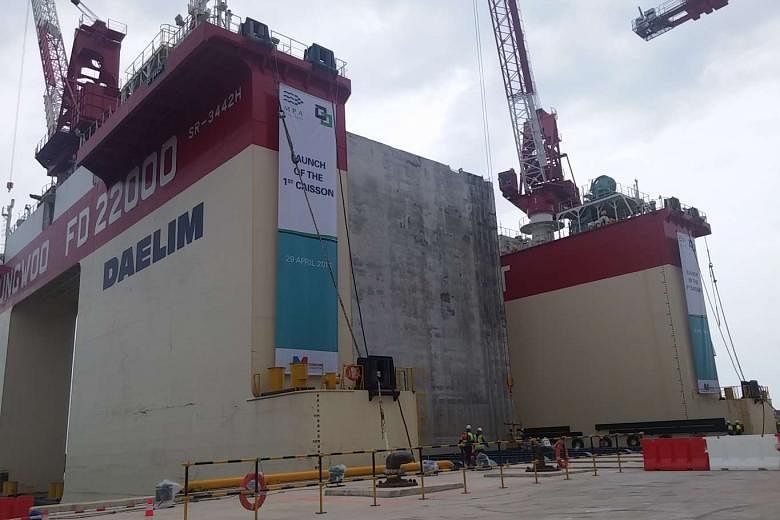SINGAPORE - The Republic's Tuas mega port has entered Phase 1 of its development. When completed it will be able to handle about 20 million 20-foot equivalent units (TEUs) of cargo a year.
The entire Tuas Terminal could eventually handle 65 million TEUs of cargo annually - nearly double what Singapore handled in 2014.
"The Tuas Terminal Phase 1 project is a testament to Singapore's commitment to sustaining its lead as a global maritime nation, and in making timely investment in port infrastructure to strengthen its global hub port position," said Mr Andrew Tan, chief executive of the Maritime and Port Authority of Singapore (MPA) on Friday (April 28).
In total, 222 caissons, which are watertight retaining structures, will form the permanent wharf structure of Phase 1 of the facility spanning 8.6km. Each caisson is 28 metres tall, equivalent to the height of a 10-storey HDB block, and weighs 15,000 tonnes making them one of the largest in the world.
It takes 10 days to build one caisson and the MPA expects to build six per month. Using caissons to build the wharf structure is much faster than other methods, such as piling, said Mr Tan, as they are of standard sizes and pre-fabricated on site.
The first such caisson was launched by Coordinating Minister for Infrastructure and Minister for Transport Khaw Boon Wan on Friday.
The Tuas Terminal will be developed in four phases over 30 years, with the Phase 1 reclamation work is scheduled to be completed by the early 2020s.
The terminal will boast new and innovative features, said Mr Tan, adding that above ground and underground spaces will be used for maritime and related industries including storage.
Port waters will also be managed using next generation port operations systems. The Next Generation Vessel Traffic Management System, for example, will help vessels to avoid congestion through early detection of congestion hot spots and advise the best route to reach the berths safely and efficiently, said Mr Tan.
Automated port equipment and automated yard cranes will also be key features.
The development of Tuas Terminal will also require the reclamation of 294 hectares of land and the dredging of the Tuas basin and Temasek Fairway.
Dredged and excavated materials from land construction projects such as Land Transport Authority's rail infrastructure projects, will be reused as reclamation fill. They will make up more than 60 per cent of the total fill materials required for the project. This reduces reliance on sea sand.
"Re-using such materials, which will be otherwise disposed of as waste, will reduce the quantity of sand fill required for reclamation, thus resulting in significant reclamation fill material cost savings of about $1 billion," said Mr Tan.
An Environmental Impact Assessment (EIA) was carried out by marine environmental experts prior to land reclamation work. They recommended that corals around Sultan Shoal lighthouse be relocated to the southern islands to preserve them.
About 2,300 out of 2,800 coral colonies were moved successfully and have survived through a $6 million coral relocation project.
The MPA has said it will monitor the health of remaining corals at Sultan Shoal between now and 2019.


